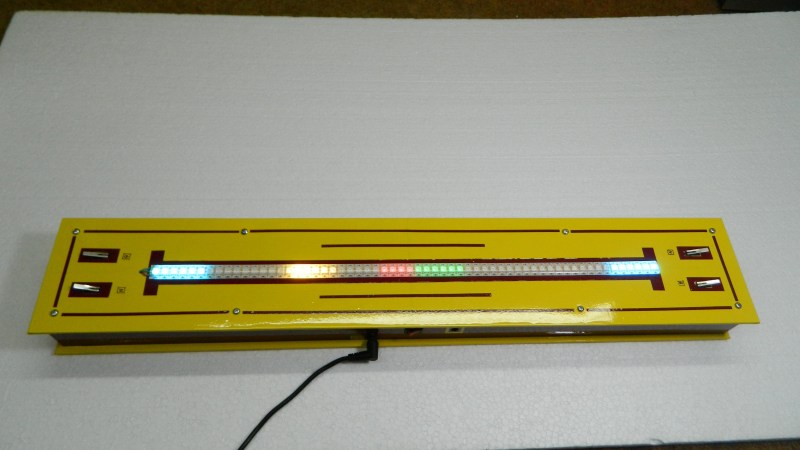When Pong hit the scene in the early 70s, there was something about the simplicity of the 2D monochrome tennis game that made it engaging enough that enthusiastic proto-gamers shorted-out machines by stuffing their coin boxes to overflowing. But even with the simplicity of Pong’s 2D gameplay, the question becomes: could it by made simpler and still be playable?
Surprisingly, if this one-dimensional Pong game is any indication, it actually seems like it can. Where the original Pong made you line up your paddle with the incoming ball, with the main variable being the angle of the carom from your opponent, [mircemk]’s version, limited to a linear game field, makes the ball’s speed the variable. Players take control of the game with a pair of buttons at the far ends of a 60-LED strip of WS2812s. The ball travels back and forth along the strip, bouncing off a player’s paddle only if they push their button at the exact moment the ball arrives. Each reflection back to the opponent occurs at a random speed, making it hard to get into a rhythm. To add some variety, each player has a “Boost” button to put a little spice on their shot, and score is kept by LEDs in the center of the play field. Video of the game play plus build info is below the break.
With just a Neopixel strip, an Arduino Nano, and a small handful of common parts, it should be easy enough to whip up your own copy of this surprisingly engaging game. But if the 2D-version is still more your speed, maybe you should check out the story of its inventor, [Ted Dabney]. Or, perhaps building a clock that plays Pong with itself to idle the days away is more your speed.
















Unsurprisingly, this has been done before, and predates Pong. Many years ago we played ping pong using the front panel lights & switches of a Data General Nova minicomputer.
Nolan Bushnell claims that pong was inspired by an “electronic tennis” on the PDP-1 in ’64, the Nova didn’t come out until, ’69 but arcade pong didn’t appear until ’72.
Which might have been a version of this.. https://www.m-e-g-a.org/research-education/research/t42-tennis-for-two/
The game-play, if not the sense of specatacle, seems similar to the “Fire Pong” I saw at EMF, in those halcyon days when we could actually go to visit a field.
https://youtu.be/900WH7Mh3eQ
Interestingly, I never uploaded the updated code for this project to my project-page. A remake in Australia some years ago inspired some extras. There are now twinkles in the display while boosting. I’d suggest that mircemk (from the HAD.io page) take a look at that new code from https://www.vagrearg.org/onedpong/one_d_pong-20161214.zip This is also the code that is running at the school where is has been in use for the past five years.
Thanks a lot, great code
Having seen linear pong games on HaD before, I assumed the headline meant one less dimension than linear pong.
How about a 2 player pong game with one RDB LED that sits there, not moving? Or use three of them. One for each player which the game sets to a specific color at the start of the turn then ramps the center one through the spectrum. The player pokes the button when judging the color matches. If successful within the (adjustable) difficulty range the ball ‘bounces’ to the opposing player.
Difficulty could be set by having different numbers of discrete colors up to a full 24bit rainbow that smoothly changes. Adjust the match range from say 5% to 0%.
Then the title would make more sense. “Linear pong loses a dimension”
It wouldn’t really be losing a dimension, because the color would represent the proposed “lost” dimension.
The original might be Coleco Zap! from 1978. https://www.handheldmuseum.com/Coleco/Zap.htm
I had one of those.
Totally awesome :-) I’ve always wondered how they were were constructed. TTL only?
I doubt it, even back then there were cheaper alternatives. I cracked open a knock-off 1970’s Simon Says game, made by Tyger, I think. It had four buttons and four LED’s and a switch. Anyway, I was hoping for some TTL or CMOS goodies so you can imagine my disappointment when all I found was a single DIP IC. I Imagine it was some kind of ASIC, PGA, or PLA. I looked up the part number, but I’ve since forgotten…
http://hackaday.com/2012/08/22/one-dimensional-pong-is-a-great-use-for-led-strips/
I wanted to build this when I saw it way back in the day.
I remember having fun with a 7-LED version that was one of the bundled games in Radio Shack’s Science Fair Microcomputer Trainer in the 80s.
I used the Vagrearg code in 2 projects so far
1. 1D Pong installed on a wooden pinball machine – https://youtu.be/CqXcsoyCDYw
2. ID ceiling pong with iPhone control – https://youtu.be/w5ExMHo6OrI
(Ported to ESP32 for easier wifi, FastLED and different sound function)